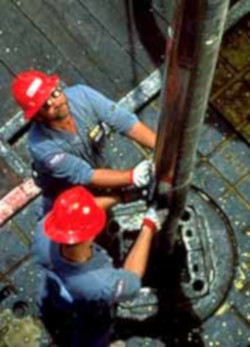Setting Production Casing
Production casing is the final casing in a well. It can be set from the bottom to the top. Sometimes a production liner is installed.

This casing is set the same as other casings, and then cemented in place.
Installing Production Tubing
A well is usually produced through tubing inserted down the production casing. Oil and gas is produced more effectively through this smaller-diameter tubing than through the large-diameter production casing.
Joints of tubing are joined together with couplings to make up a tubing string. Tubing is run into the well much the same as casing, but tubing is smaller in diameter and is removable.
The steps for this activity are:
- Tubing elevators are used to lift tubing from the rack to the rig floor.
- The joint is stabbed into the string, which is suspended in the well, with air slips.
- Power tongs are used to make-up tubing.
- This process is repeated until tubing installation is complete.
- The tubing hanger is installed at the wellhead.
New technology allows tubing to be manufactured in a continuous coil, without joints. Coiled tubing is inserted into the well down the production casing without the need for tongs, slips, or elevators, which takes considerably less time to run.
Let's take a look at the potential hazards and possible solutions when installing production tubing in the next tab.
Knowledge Check Choose the best answer for the question.
1-4. Why is oil and gas produced through smaller-diameter tubing than through the large-diameter production casing?
You forgot to answer the question!
